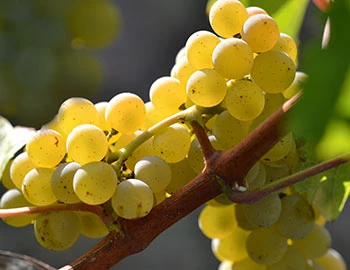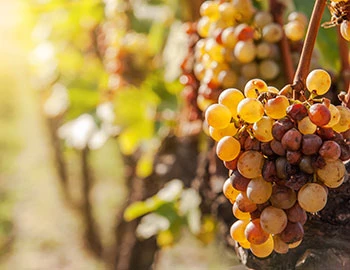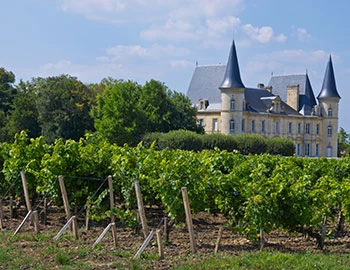
Secret de Château Biac 2015
AC Cadillac, 500 ml

| Grape variety: | Sémillon, Sauvignon Blanc |
| Producer: | Château Biac |
| Origin: | France / Bordeaux / Premières Côtes de Bordeaux |
Description
A golden "nectar" made according to the old Bordelais sweet wine tradition: meticulous grape selection. Château Biac's "secret" from Cadillac is a meditation wine and an excellent companion to cheese and fruit tartes as well as foie gras and brioche. Drink it chilled, but not too cold. The sweet wine smells enchantingly of dried apricots, white peaches, white flowers and a little vanilla and saffron. Silky and lush, it coats the palate. Notes of candied orange zest, quince jelly and honeycomb characterise the palate. Balanced, soft and lively!
Attributes
| Origin: | France / Bordeaux / Premières Côtes de Bordeaux |
| Grape variety: | Sémillon, Sauvignon Blanc |
| Ripening potential: | 2 to 15 years |
| Drinking temperature: | 10 to 12 °C |
| Food Pairing: | Foie gras, Goat's cheese, Blue cheese, Fruit tart |
| Harvest: | hand-picking, strict selection, in several rounds (tries), grapes infected with botrytis |
| Maturation: | in used barriques |
| Maturation duration: | 16 months |
| Volume: | 13.5 % |
| Note: | Contains sulphites |
Château Biac
Sometimes life is full of surprises. The Lebanese Asseily family experienced this first-hand when they became the owners of Château Biac as if by accident in 2006. They regularly spent their summer holidays near Biac, but never would they have dreamt that they would own and manage this wonderful property themselves one day. It’s a fascinating story that Tony and Youmna Asseily are happy to share over a glass of their wine.
Château Biac isn’t located in one of the world-famous towns on the left or right bank of the Gironde, but on the Graves plateau south of Bordeaux in the small town of Langoiran. Idyllically situated, the winery offers a magnificent view of a meander of the Garonne to the south-southwest.
Biac was first mentioned in the 17th century. The present-day château dates back to 1755 and was built by the daughter of the Baron de Langoiran. At the end of the 19th century, Château Biac enjoyed an excellent reputation, not least because the vineyards were only planted with selected Château d’Yquem vines and red vines from the finest wineries in Saint-Émilion. By 2006, however, the winery was in a sad and neglected state.
The Asseily family quickly realised that it would require a lot of work to restore Château Biac’s reputation as one of the finest wineries in the region. They sought professional advice and support, including from Patrick Léon, who had been an oenologist at Château Mouton-Rothschild for 20 years. A thorough soil analysis was carried out and the planting of the vineyards was adapted accordingly, as the soil structure turned out to be extremely diverse. But not only the vineyards, but also the infrastructure of the wine cellar and the buildings were modernised and adapted to the new needs.

Sauvignon Blanc
The Sauvignon blanc can be recognized with your eyes closed. Its typical bouquet is marked by green notes: freshly cut grass, tomato bunches, gooseberry. Citrus fruits, cassis and flint join into the mix. In warmer latitudes it also shows exotic aromas, such as passion fruit. Its acidity is decidedly lively. In all likelihood, it comes from the Loire Valley, where it is vinified in Pouilly-Fumé and Sancerre in its purest form: varietally, and without timber. In the 18th century, it found its way to Bordeaux. Ambitious producers assemble it there with Sémillon into substantial whites, which are aged in oak barrels. The Sauvignon blanc has been a sensational success in the past 20 years in New Zealand. With its refreshing sweet-and-sour style, winemakers from down under have conquered the world. The rich Sauvignons from Styria and crisp examples of South Tyrol and Friuli are worth mentioning as well. It pairs with anything from the sea. Or do it like they do on the Loire, and enjoy it with goat cheese.

Sémillon
The fungi be thanked
The Sémillon grape is the basis of the legendary sweet wines of Sauternes. Its origins are there, in the southern part of the Bordeaux region. Its secret to success is its susceptibility to the Botrytis fungus, which pierces the skin of the ripe berries. Thus the water evaporates, and the sugar in the fruits concentrates. The musts are as thick as syrup. They present the citrus-fresh, fruity aromas of the Sémillon varieties. In addition, the Botrytis fungus contributes complex notes of honey, dry apricot and candied orange to the wine. The Sémillon is closely related to the Sauvignon blanc, and almost all sweet wines from Sauternes and its surroundings contain a small proportion of Sauvignon. The dry whites from Bordeaux are the opposite: the Sémillon mostly plays the supporting role. In early-19-century South Africa, Sémillon was the most planted grape. However, only vanishingly small quantities still grow there today. However, the vine has since taken root in California and Australia.

Premières Côtes de Bordeaux
Premières Côtes de Bordeaux: Upswing in the province
Even far from the classified crus, Bordeaux today has more to offer than ever before in its history. The nobly composed Premières Côtes de Bordeaux appellation sits on the right bank of the Garonne River, almost across from its counterpart, the better-known Graves AOC. Recent vintages, however, have demonstrated that the Premières Côtes deserve greater attention as well. Along with classic red cuvées, white Moelleux wines with high residual sugar are produced in the area.

Bordeaux
Bordeaux: high prestige, high quality
With a total area of around 115,000 hectares, Bordeaux may not be France’s largest wine-growing region, but it is certainly its most prestigious. The range of wines produced here today is enormous: ranging from red everyday wines with a great relationship between price and quality to exclusive, and accordingly expensive, premier crus. Elegant white wines and noble sweet specialties round out the spectrum.

France
France – Philosophy in a bottle
According to French philosophy, wine should be an expression of the soil and climate. They use the word “terroir” to describe this. Terroir makes every wine different, and many especially good. French wine is regarded worldwide as an expression of cultural perfection. The French believe that humans are responsible for the quality of the berries, the vine variety for their character, and nature for the quantity. This philosophy can be expressed succinctly as: “the truth is the vineyard, not the man.”


